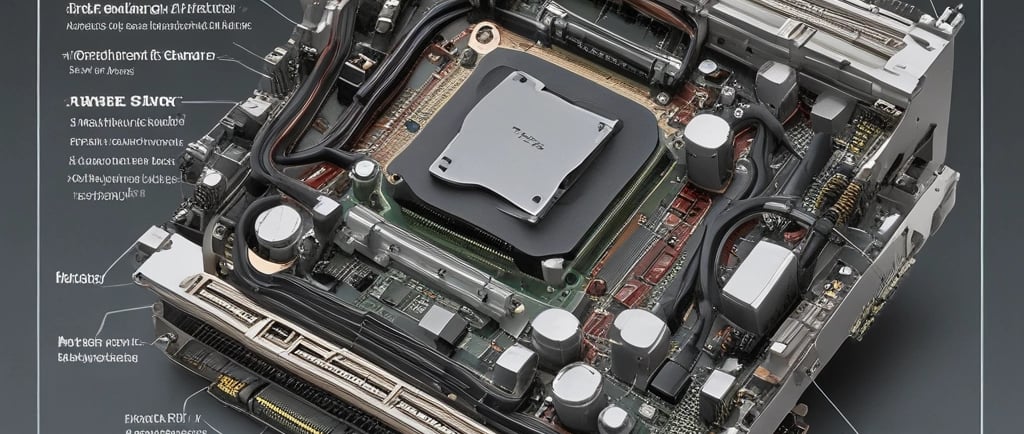PowerPC 970: Apple’s 64-bit Computing Revolution
Discover the PowerPC 970, Apple's innovative processor that served as a bridge to 64-bit computing, enhancing performance and capabilities in Apple devices. Explore its impact on Apple processors and the evolution of technology.
Lyla amber
10/3/20253 min read


In the annals of computer history, certain processors stand out not just for their technical achievements, but for their strategic importance in shaping the industry. The PowerPC 970, famously known as the G5 in Apple computers, is one such chip. It represented a bold gamble, a technical triumph, and ultimately, a transitional architecture that paved the way for a revolutionary shift in personal computing.
The Genesis: A Marriage of IBM and Apple Ambitions
In the early 2000s, Apple's "G4" processors, supplied by Motorola, were hitting a performance wall, particularly in clock speed. This led to the infamous "Megahertz Myth" advertising campaign from Intel, highlighting the gulf in raw clock rates between PowerPC and Intel processors. Apple needed a dramatic response.
The answer came from IBM. The 970 was a derivative of IBM's mighty POWER4 processor, which powered the company's high-end servers and supercomputers. IBM's goal was to bring POWER architecture to a broader market, while Apple's was to secure a high-performance, 64-bit engine for its professional desktops. The PowerPC 970 was the perfect meeting point.
Architectural Brilliance: Bringing Server Power to the Desktop
The 970 was a technological marvel for its time, packing features that were revolutionary in a consumer-level CPU.
The 64-Bit Leap
Its most headline-grabbing feature was its 64-bit architecture. At a time when Intel and AMD were still pushing 32-bit x86 processors (the first AMD64 chips emerged around the same time), the G5 gave Apple a powerful marketing claim: the "world's first 64-bit desktop computer." This 64-bit capability provided a massive memory address space, crucial for scientific computing, video editing, and large Photoshop files.
Advanced Microarchitecture
Dual Computational Engines: The 970 featured two separate, symmetrical arithmetic logic units (ALUs) and two floating-point units (FPUs). This allowed it to execute more instructions per clock cycle, making it exceptionally potent for media processing and scientific workloads.
Velocity Engine: Apple's branding for AltiVec, a powerful 128-bit SIMD (Single Instruction, Multiple Data) unit. This was a workhorse for audio, video, and image processing, often outperforming anything in the x86 world for these specific tasks.
Rapid Execution: With a deep, 16-stage pipeline, the 970 was designed to achieve high clock speeds. It quickly raced to 2.0 GHz and beyond, finally allowing Apple to compete with Intel on the megahertz front.
The Apple Implementation: Triumph and Tribulation
Apple launched the Power Mac G5 in June 2003 with great fanfare. Jony Ive's brilliant industrial design housed the processor in a stunning aluminum enclosure, with a distinctive asymmetrical side that hinted at the power within.
The G5 was a beast. In tasks that leveraged its strengths—especially those optimized for AltiVec and 64-bit code—it was untouchable. It became the darling of creative professionals, audio engineers, and scientists.
However, the G5's server heritage also brought significant challenges:
The Thernal and Power Ceiling
The POWER4 was designed for servers with robust cooling systems. Scaling it down for a desktop chassis proved difficult. The 970, especially at higher clock speeds, was a power-hungry, hot-running chip. Apple's solutions became increasingly extreme—from complex liquid-cooling systems in high-end models to the famously wind-tunnel-tested Power Mac G5 case with its 36 fans.
The Mobile Wall
This thermal footprint was the primary reason a PowerBook G5 never materialized. Apple's engineers simply could not tame the chip's heat and power consumption in a laptop form factor. This critical limitation highlighted the architecture's fundamental mismatch with the industry's move toward mobile computing.
The Legacy: A Pivotal, Yet Transitional, Role
The PowerPC 970's story is one of both triumph and transition.
Its Lasting Impact:
Proved 64-Bit on the Desktop: It demonstrated the tangible benefits of 64-bit computing to a broad audience years before it became the x86 standard.
Raised the Performance Bar: It forced the entire industry, particularly Intel, to take Apple and the PowerPC platform seriously as a high-performance competitor.
The Rosetta Precedent: The architectural gulf between PowerPC and Intel x86 was so vast that Apple had to develop the original Rosetta translation software for its Intel transition. This experience was invaluable when they later repeated the feat for the Apple Silicon transition.
Why It Was Replaced:
The G5's insatiable appetite for power and its inability to fit into a laptop created a strategic crisis for Apple. The future was mobile, and the PowerPC roadmap could not deliver a suitable mobile processor. This directly led to Steve Jobs' shocking announcement in 2005 to transition the entire Mac line to Intel processors, a process completed in 2006.
Conclusion: The Bridge to the Future
The PowerPC 970 was not a failure; it was a magnificent bridge. It carried Apple from the performance-compromised G4 era, through the brave new world of 64-bit computing, and positioned the company to make its next strategic leap. It gave developers and users a taste of high-performance, 64-bit computing and set a standard that Intel would have to meet.
While its reign was short-lived, the G5's spirit of ambitious, high-performance computing lived on. It can be seen as a direct ancestor of today's Apple Silicon—another bold, custom-designed, power-efficient architecture that once again redefined what was possible in a personal computer. The PowerPC 970 was the necessary, brilliant, and fiery catalyst for one of the most important transitions in Apple's history.